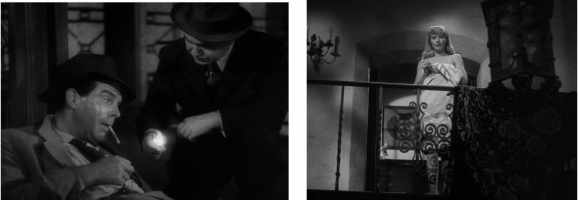


Against such a background, ‘the femme fatale emerges as a “victim of the misogynistic, violent men around her”, and the female is simply presented to be a “virtual prisoner of her heterosexual relations”. Lola Dietrichson, the nineteen year old step daughter, is seen as the “perfect” example of femininity: “wearing a filmy party dress and a yearning look in her pretty eyes”, who is initially coupled with a Nino Zucetti, who she describes to be “hot-headed” and in possession of a raw youthful aggression. The combination of characters, based on their gender is seen to be the portrayal of the formation of an “existential partnership”, based on the primitive concepts of gendered social spaces. The film portrays a divergence from the “gender binaries”: of what constitutes masculinity and femininity, and questions the discrepancy in the ‘expected and the actual behavior’ as seen through the characters of the femme fatale Phyllis, who stands out in contrast to her step-daughter Lola and between Walter Neff, one of the two protagonists, who is seen in a different light than his colleague, Keyes. Instructions for Submission and Guidelines are provided on the Atlantis website and in the printed copies.Double Indemnity, through the continuous constraints set by the film noir is seen to be criticizing gender differences, by setting up a stage where the characters are constantly seen to be in breach of gender ideals and conventionally determined narrow boundaries which seem to dictate expected behavior. Submissions may be made electronically at any time to the General Editor. Selected papers are published both in print and online. The suitability of manuscripts for publication is determined on the basis of double-blind reports by specialists in the area. No submission should be under consideration for publication elsewhere. Reviews of scholarly monographs and interviews are also published. Pertinent cross-cultural and interdisciplinary analyses are welcome. The scope of the journal covers literatures in English, Critical Theory, thought and culture, including film, of English-speaking communities, together with studies in linguistics, discourse analysis and pragmatics. It accepts original, unpublished research articles in English by scholars from both Spain and abroad. The conclusion of this analysis leads us to reject the monolithic assumption that all classical films conform to the predominant ideology enhanced by the pleasure of a realistic mode.įounded in 1979, Atlantis is a peer-reviewed scholarly journal published twice-yearly by the Spanish Association of Anglo-American Studies (AEDEAN). The two main sections of the paper attempt to show how Double Indemnity satisfies Classical Hollywood conventions and how the convergence of polarities within the formal elements contravenes its thematic paradigm, thus creating a pervading ambivalence. Poststructuralist theories as well as psychoanalysis and feminism have been used as an analytical framework in order to unveil the hidden strategies of the dominant ideology in the film and show up its fissures and contradictions, thus providing an alternative reading which subverts such cultural hegemony. This paper analyses those elements (stylistic and thematic) in Billy Wilder's Double Indemnity (1944) that can be considered dissident variations of the dominant film-making conventions - the Classic Hollywood's basic formulae- subverting the film's intended ideological effect.


 0 kommentar(er)
0 kommentar(er)
